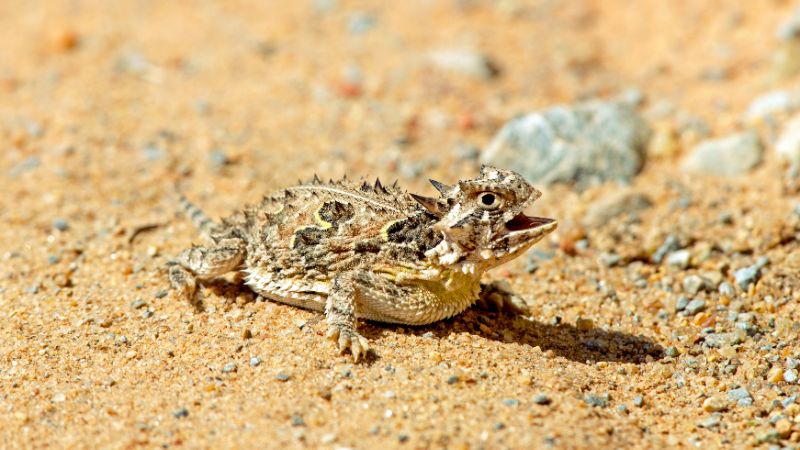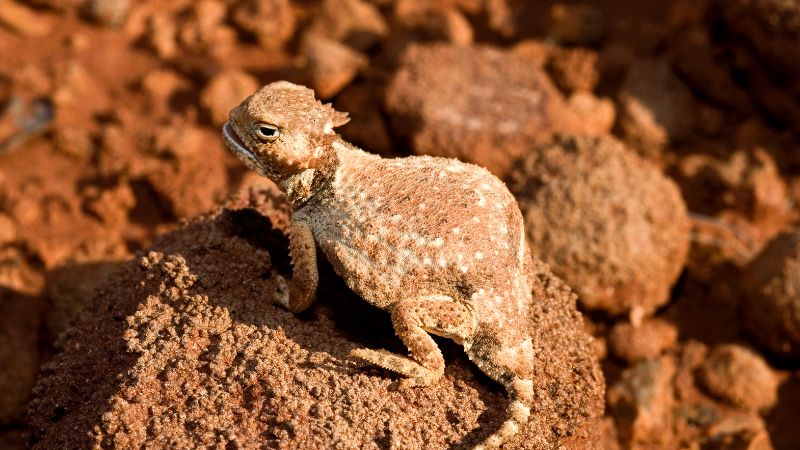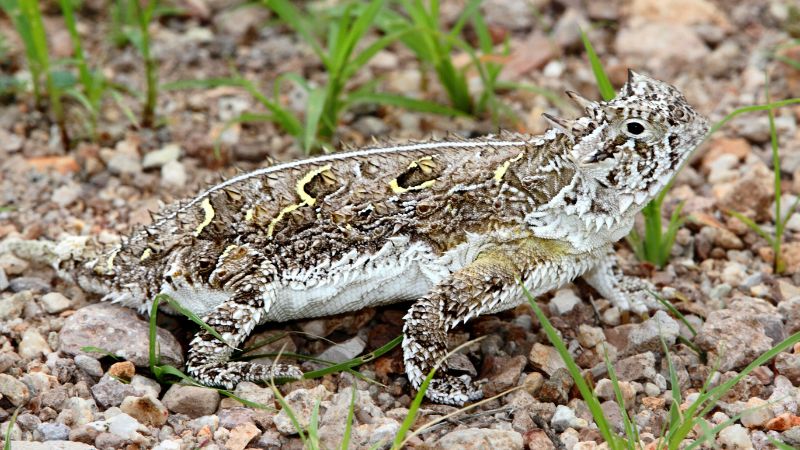These spiky reptiles might be scary to look at but they’re actually extremely docile and were once popular pets. You have to be extra careful when getting rid of Texas horned lizards as they are protected in some states.
So, how to get rid of Texas horned lizards? You can do so by applying a spot treatment pesticide to remove harvester ants—which are the lizard’s main food source—as well as maintain turfgrass density in your lawn and support local conservation efforts for these lizards.
Want to know more? This article has got you covered with everything you need to know about Texas horned lizards and how you can prevent them from ever coming back to your property.
What Are Texas Horned Lizards?

Texas horned lizards (Phrynosoma cornutum), as their name suggests, are small lizards with horned scales. They have short, rounded bodies that they can either inflate to make their spikes protrude more or flatten if they want to hide.
They are naturally occurring from Arizona to Louisiana but have been introduced in various southeastern states. Although there are successfully established breeding populations, it’s unlikely for this species to become invasive.
What Do Texas Horned Lizards Like?
They like to bask in direct sunlight in the morning and late afternoon so that they can regulate their body temperature. This is why Texas horned lizards are usually found on roads, utility poles, and fences during these times.
What Do Texas Horned Lizards Eat?
Texas horned lizards show a preference to harvester ants and other ant species. In fact, these reptiles are willing to wait outside ant colonies to catch prey. They also consume other insects when available.
Related: What Do Backyard Lizards Eat? | Information and Facts
Where Do Texas Horned Lizards Live?
Texas horned lizards prefer habitats that have arid or semi-arid temperatures and easy access to open areas and vegetative cover. This includes deserts, dunes, and prairies.
How Long Does Texas Horned Lizards Live?
They have a lifespan of up to 9 years in captivity, if provided with the proper care such as installing heat lamps and feeding the correct food. It is unknown how long they live in the wild but there are documentations of 5 year-old lizards.
How Big Will Texas Horned Lizards Get?
Adult lizards grow up to a minimum of 7 centimeters. Females are typically larger, reaching up to 11 centimeters in snout-to-vent length while males grow up to 9 centimeters. Their weight ranges from 25 to 90 grams.
What Is the Behavior of Texas Horned Lizards?
Texas horned lizards are solitary creatures, only socializing with others during mating season or when competing for food sources. They are initially skittish when they’re young but eventually learn to stay motionless when facing danger.
Moreover, these reptiles hibernate by burying themselves under foliage, litterfall, or soil from October until late March. Their main mode of communication is through head bobbing.
The Pros and Cons of Texas Horned Lizards
The Texas horned lizard plays an essential ecosystem role of controlling harvester ant populations. Possibly their only con is that they may lunge at humans and bite them if they feel threatened.
Are Texas Horned Lizards Dangerous?

No, they are an extremely docile species and are harmless to humans unless, of course, they are threatened. In this case, they may lunge and/or bite as a form of self-defense.
Should I Get Rid of Texas Horned Lizards?
Yes, but in ways that don’t require you to touch, pick up, or handle them as these actions are deemed illegal in some states due to their “threatened” conservation status.
Related: How to Get Rid of Brown Anole Lizards Naturally | Essential Tips!
Signs of Texas Horned Lizards Infestation
If you see fecal droppings, severed tails, claw marks on furniture or walls, nests found in loose soil, or destroyed harvester ant colonies, you may have a Texas horned lizard infestation in your property.
Why Would You Want to Get Rid of Texas Horned Lizards?

It’s understandable if you want to get rid of them because you’re scared that they would harm you. Although they’re generally harmless, they can still lunge at you and bite if you seem threatening enough for them.
How to Get Rid of Texas Horned Lizards?
Remember that getting rid of these reptiles require indirect methods. Here are some you can try:
- Remove food sources. In particular, apply a spot treatment pesticide to kill harvester ants. Cutting off their food supply will make them leave your property and forage elsewhere.
- Maintain density of turfgrass. Texas horned lizards prefer having open areas where they can have access to direct sunlight. Make sure that the density of grass in your lawn is even to eliminate these areas.
- Support local conservation efforts. Donate if you can and find ways you can contribute to protecting Texas horned lizard habitats in the wild.
Related: How to Get Rid of Mediterranean House Geckos | Simple Solutions for Quick Removal
How to Prevent Texas Horned Lizards From Getting Into Your Property?

As mentioned earlier, getting rid of harvester ants through the use of spot treatment pesticides and maintaining vegetation density in your lawn, yard, or garden can help prevent Texas horned lizards from coming back.
Related: 9 Best Lizard Repellents That Actually Work | A Detailed Guide
List of Sources
Henke, S. E., & Fair, W. S. (n.d.). Management of Texas Horned Lizards.
Missouri Department of Conservation. (n.d.). Texas Horned Lizard.
Pianka, E. R., & Hodges, W. L. (n.d.). Horned Lizards, Part 2.
University of Georgia. (n.d.). Texas Horned Lizard (Phrynosoma cornutum) – Introduced.
Walker, A. (n.d.). Phrynosoma cornutum: Texas Horned Lizard.
- How to Get Rid of Turtles | Proven Long-Term Solutions! - August 26, 2023
- How to Get Rid of Kingsnakes | Easy & Humane! - August 26, 2023
- How to Get Rid of Northern Water Snakes | Best Solutions and Preventative Measures! - August 19, 2023

